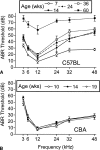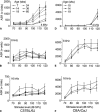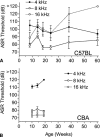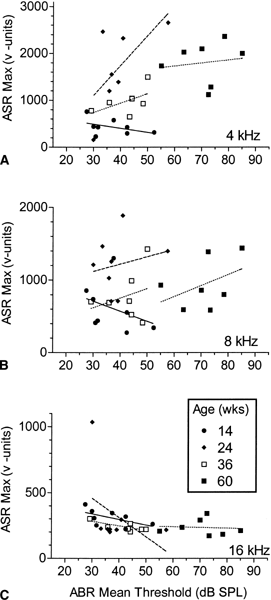Low-frequency tone pips elicit exaggerated startle reflexes in C57BL/6J mice with hearing loss
- PMID: 12784135
- PMCID: PMC3202743
- DOI: 10.1007/s10162-002-3046-2
Low-frequency tone pips elicit exaggerated startle reflexes in C57BL/6J mice with hearing loss
Abstract
The strength of the acoustic startle reflex (ASR) as a function of age was studied in adult C57BL/6J and CBA/CaJ mice, because altered ASR levels are a potential behavioral consequence of the neural reorganization that accompanies the early-onset hearing loss of the C57BL, in contrast to the normal-hearing CBA. For C57BL mice at 14-36 weeks of age, compared with 7-week-old mice, high-frequency thresholds measured with the auditory brainstem response (ABR) were less sensitive by about 25-30 dB while the hearing loss at low frequencies was 10-15 dB, but by 60 weeks losses of 45-50 dB were present across the entire spectrum. Their ASR amplitudes for 16 kHz tone pips were highest at 7 weeks and then declined with age, but, for 4 kHz tones the ASR increased in strength at 18 weeks and beyond to levels above that of the younger mice. This hyperreactivity persisted even in 60-week-old mice. The ASR for 16 kHz stimuli was positively correlated with hearing sensitivity, but the ASR for 4 kHz stimuli was positively correlated with hearing loss for mice that were 18-36 weeks of age. Furthermore, ASR amplitudes for 4 kHz stimuli were positively correlated with the 16 kHz ASR in young C57BL mice but negatively correlated in older mice. There were no similar ASR or ABR changes in adult CBA mice through 19 weeks of age. Correlations between ASR and ABR scores were always weakly positive, and correlations between 4 kHz and 16 kHz ASR amplitudes were always strongly positive. The ASR data in older C57BL mice with hearing loss are consistent with reports describing their increased neural representation of low-frequency sounds and reinforce the value of this strain for studying the functional consequences that accompany age-related cochlear degeneration.
Figures




Similar articles
-
Age-related hearing loss in C57BL/6J mice has both frequency-specific and non-frequency-specific components that produce a hyperacusis-like exaggeration of the acoustic startle reflex.J Assoc Res Otolaryngol. 2007 Dec;8(4):539-50. doi: 10.1007/s10162-007-0098-3. Epub 2007 Oct 19. J Assoc Res Otolaryngol. 2007. PMID: 17952509 Free PMC article.
-
Acoustic startle response in young and aging C57BL/6J and CBA/J mice.Behav Neurosci. 1988 Dec;102(6):881-6. doi: 10.1037//0735-7044.102.6.881. Behav Neurosci. 1988. PMID: 3214538
-
Effects of age-related hearing loss on startle reflex and prepulse inhibition in mice on pure and mixed C57BL and 129 genetic background.Behav Brain Res. 2006 Sep 25;172(2):307-15. doi: 10.1016/j.bbr.2006.05.018. Epub 2006 Jun 30. Behav Brain Res. 2006. PMID: 16814879
-
Genetic influences on susceptibility of the auditory system to aging and environmental factors.Scand Audiol Suppl. 1992;36:1-39. Scand Audiol Suppl. 1992. PMID: 1488615 Review.
-
Revisiting Psychoacoustic Methods for the Assessment of Fish Hearing.Adv Exp Med Biol. 2016;877:157-84. doi: 10.1007/978-3-319-21059-9_8. Adv Exp Med Biol. 2016. PMID: 26515314 Review.
Cited by
-
Electrophysiological assessment and pharmacological treatment of blast-induced tinnitus.PLoS One. 2021 Jan 7;16(1):e0243903. doi: 10.1371/journal.pone.0243903. eCollection 2021. PLoS One. 2021. PMID: 33411811 Free PMC article.
-
Acoustic Hearing After Murine Cochlear Implantation: Effects of Trauma and Implant Type.Ann Otol Rhinol Laryngol. 2015 Dec;124(12):931-9. doi: 10.1177/0003489415592162. Epub 2015 Jun 19. Ann Otol Rhinol Laryngol. 2015. PMID: 26091845 Free PMC article.
-
Noise-induced tinnitus using individualized gap detection analysis and its relationship with hyperacusis, anxiety, and spatial cognition.PLoS One. 2013 Sep 12;8(9):e75011. doi: 10.1371/journal.pone.0075011. eCollection 2013. PLoS One. 2013. PMID: 24069375 Free PMC article.
-
Noise and Vibration in the Vivarium: Recommendations for Developing a Measurement Plan.J Am Assoc Lab Anim Sci. 2020 Nov 1;59(6):665-672. doi: 10.30802/AALAS-JAALAS-19-000131. Epub 2020 Sep 14. J Am Assoc Lab Anim Sci. 2020. PMID: 32928338 Free PMC article.
-
Age-dependent structural reorganization of utricular ribbon synapses.Front Cell Dev Biol. 2023 Aug 10;11:1178992. doi: 10.3389/fcell.2023.1178992. eCollection 2023. Front Cell Dev Biol. 2023. PMID: 37635868 Free PMC article.
References
-
- Brant LJ, Fozard JL. Age changes in pure-tone hearing thresholds in a longitudinal study of normal human aging. J. Acoust. Soc. Am. 1990;88:813–820. - PubMed
-
- Carlson S, Willott J. Caudal pontine reticular formation of C57BL/6J mice: responses to startle stimuli, inhibition by tones, and plasticity. J. Neurophys. 1998;79:2603–2614. - PubMed
Publication types
MeSH terms
Grants and funding
LinkOut - more resources
Full Text Sources
Other Literature Sources
Medical
Miscellaneous

